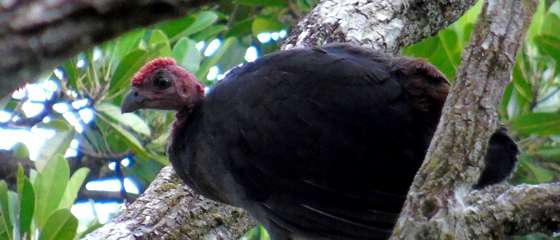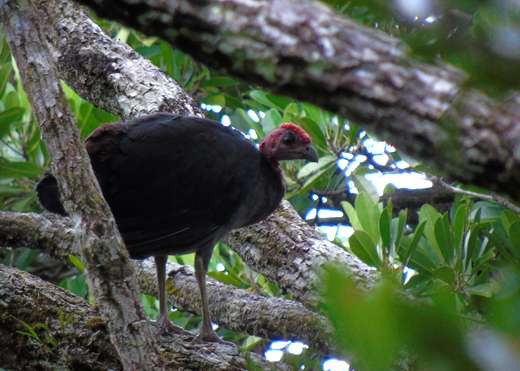First ever footage of rare wild turkey provides early Christmas present

Bake slowly at 33C in the centre of a compost heap for several months. If that sounds like an unconventional way to cook your turkey this Christmas, imagine having to build your own oven before you start. The rare and elusive Waigeo brush-turkey, which has just been captured on video for the first time, has its own interpretation of the phrase 'oven-ready'.
Although it bears a superficial resemblance to a miniature turkey or overgrown chicken, the Waigeo brush-turkey is actually a megapode. These resourceful birds dispense with the usual practice of incubating their own eggs. Instead, they use their disproportionately large feet to scrape together a massive nest-mound of rotting vegetation, which serves as a makeshift oven. The male bird regulates the internal temperature of this natural incubator by removing or adding leaf litter. When the chicks are ready to hatch, they kick their way out of their shells and tunnel to the surface.
The first ever video recording of this remarkable bird – which is found only in a very small area of Waigeo, the largest of the four main islands in West Papua's Raja Ampat archipelago – was secured during recent camera trap surveys that are helping to map and monitor the unique and threatened biodiversity of Raja Ampat's rainforest.
The archipelago is renowned as a diving hotspot, and its reefs boast an astounding diversity of coral and fish species. The rainforests of West Papua are also among the most biologically rich habitats on the planet, and one of the last refuges of the region's spectacular wildlife, including threatened tree kangaroos, birds of paradise and a spotted cuscus (an Australasian marsupial) found only on Waigeo.
These natural riches are under severe pressure from illegal logging, mining, road building, plantation development and ill-advised infrastructure projects, which are having a detrimental impact on both biodiversity and the impoverished local communities whose livelihoods and well-being depend on the resources and ecosystem services that the forest provides.
Since 2014, with financial support from Germany's Federal Ministry for Economic Cooperation and Development, Fauna & Flora International (FFI) and OroVerde – Tropical Forest Foundation have been working with Indonesia's Ministry of Environment and Forestry, and with local partners Yayasan Nazaret Papua and Belantara Papua, to combat illegal logging and wildlife trade activities, and support wise use of forest resources and the development of sustainable livelihoods, through a programme of initiatives that include community-based ecotourism and agroforestry.
Ir. Agung Setyabudi, MSc, Head of Natural Resources Conservation Agency (BKSDA), West Papua, Ministry of Environment and Forestry stated, "The government is very pleased that the project team has obtained this exciting video of such a little-known bird in one of the nature reserves on Waigeo. It underlines the need to safeguard these reserves against infrastructure development and to ensure that visitors are carefully managed in order to avoid excessive disturbance."
Throughout the latter part of the 20th century, the Waigeo brush-turkey defied all attempts to track it down. It was not rediscovered until 2002, and the first ever photograph of the species in the wild was obtained as recently as 2007. The species is officially categorised as Endangered by IUCN, due to its very restricted range and small population size, believed to number around 980 mature individuals.

According to Martin Baumann of OroVerde, the recent camera trap surveys are merely scratching the surface of what Waigeo and the other islands of Raja Ampat have to offer: "The Waigeo brush-turkey is just one of numerous threatened species that are unique to the archipelago, including many that are new to science. It is therefore vital that adequate conservation measures are taken to minimise the impact of infrastructure development and uncontrolled tourism."
"This is a great example of scientific and local knowledge combining to uncover the biological riches of Indonesia", said FFI's local partner Maurits Kafiar. "I hope that the Waigeo brush-turkey becomes a flagship species for the conservation of Waigeo's forest."
Meanwhile, the project is entering its next, crucial phase, putting in place further building blocks to support a comprehensive land use and conservation plan for the archipelago, which would pave the way for Raja Ampat's proposed designation as a World Heritage site.
Provided by Fauna & Flora International




















